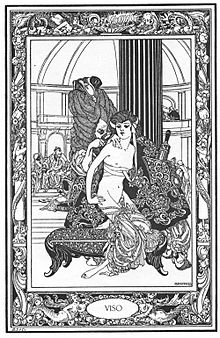Viso (Giambattista Basile)

Viso ( Neapolitan original: Lo Viso , the face) is a fairy tale (cf. AaTh 410, 313). It is in Giambattista Basile 's Pentameron collection as the third story of the third day (III, 3). Benedetto Croce Italian edition of 1957 wrote the title Il "bianco viso" what Adolf Potthoff with the bright face translated.
content
Because his daughter Renza is supposed to lose her life with a bone, the king locks her in the tower. One day she was talking to a prince through the window and breaking through the wall with the help of a dog bone. The prince has fun with her and leaves her on the way when his mother writes that she is dying. Renza follows him disguised as a man and tells him verses about his lonely wife, which he always wants to hear. At home his mother has found a bride for him. Renza is allowed to eat and complains alone in the garden while the couple are talking. While going to bed, Renza has to repeat the verses to him until that becomes too much for the bride. Renza dies at the sound of the kiss. Then he recognizes her and stabs himself.
Remarks
The title refers to the magical verse: "O ianco viso, deh chi me t'ha levato da lo canto?" (O pale face, oh tell me, who took you away from me?), Which the Prince too late to his Bride remembers. Basile's lament in the garden is widespread. The sad ending, unexpected for a fairy tale, is reminiscent of dramas like Romeo and Juliet . Rodolino is similar in Straparola's Piacevoli notti . The motif 'hero forgets his bride' already exists in Troyes' Yvain (later Aues Iwein ), the maiden in the tower near Danaë . Compare with Basile on the breakout from the tower IV, 5 The dragon , II, 1 Petrosinella , V, 5 Sun, moon and Thalia , on the forgotten bride in man's dress III, 6 The garlic forest , III, 9 Rosella , IV, 6 The three Kronen , V, 3 Pinto Smauto , V, 9 The three lemons . See Grimms Märchen No. 50 , 56 , 88 , 89 , 127 , 113 , 186 , 193 , 198 , 59a .
As Walter Scherf remarks, the mother is missing here, the father there. But while Renza breaks off and fights for the man, he falsifies the premonitions of independent love into empty repetition, unable to look her "face".
literature
- Giambattista Basile: The fairy tale of fairy tales. The pentameron. Edited by Rudolf Schenda. CH Beck, Munich 2000, ISBN 3-406-46764-4 , pp. 231-239, 545-546, 596-597 (based on the Neapolitan text of 1634/36, completely and newly translated).
Web links
- www.alaaddin.it: Bianco Viso in the Neapolitan original and in Italian
- Gutenberg-DE: Renza in German translation (probably after Felix Liebrecht)
- Staatliche Kunstsammlungen Dresden: Pictures by Josef Hegenbarth for The Bright Face : [1] , [2] , [3] , [4]
- Face in verse by Laura Bobrow (English)
Individual evidence
- ↑ Walter Scherf: The fairy tale dictionary. Volume 1. CH Beck, Munich 1995, ISBN 978-3-406-51995-6 , p. 488.
- ^ Giambattista Basile: The fairy tale of fairy tales. The pentameron. Edited by Rudolf Schenda. CH Beck, Munich 2000, ISBN 3-406-46764-4 , p. 549 (based on the Neapolitan text of 1634/36, completely and newly translated).
- ↑ Walter Scherf: The fairy tale dictionary. Volume 1. CH Beck, Munich 1995, ISBN 978-3-406-51995-6 , pp. 487-491.